Northern Lithuania feels like a whisper through birch trees, footsteps on gravel, the hush of old grief. Then I get to this place, just outside Šiauliai, and the whispers become a scream. A silent kind of scream. Welcome to the Hill of Crosses.
At first, it feels like a religious curiosity. An oddball stop on a Baltic road trip. But then it starts to hit harder when I see the sheer scale of it. The hill is covered to the brim with hundreds of thousands of crosses, crucifixes and rosaries stabbed into the earth like defiance incarnated. This is the Kryžiu Kalnas, or simply Hill of Crosses.
 Hill of crosses.
Hill of crosses.
Some say it began after the 1831 uprising against the Russian Empire, when families had nowhere to mourn their dead. One cross led to the other, as a way of honoring the casualties.
 Hill of crosses.
Hill of crosses.
 Hill of crosses.
Hill of crosses.
Today, 40 years later, the hill is once more filled with crosses, as a middle finger to tyranny. It’s not just a Catholic thing. It’s a Lithuanian thing, the very human condition nailed to a hillside in the middle of nowhere. A place heavy with intention.
I walk across the hill and think of the unlimited power of the human spirit. It feels like trespassing on someone’s secret. Every cross tells a story. Some are hand-carved, others are cheap souvenirs. Doesn’t matter. What matters is that they are here. Someone carried them. Someone believed.
Related posts

Comments
No comments yet.
Leave a reply